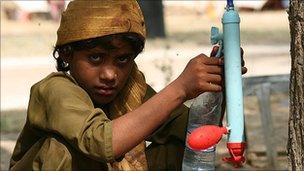The gadgets for disaster zones
- Published
Will Crawford and Peter Brewin came up with the design while at university
This year has seen a string of natural disasters and violent conflicts. But for those whose lives are in jeopardy - which recent inventions could prove significant?
Japan is recovering from a massive tsunami, Ivory Coast is reeling from a bloody power struggle, and Libya is facing a huge refugee crisis.
Thousands of people in these countries have lost their homes or been without safe or reliable access to food, water and medical supplies.
Many recent innovations have shown the potential to help them - but are yet to overcome cost hurdles.
Take Concrete Canvas Shelters, for example. British engineers Peter Brewin and Will Crawford came up with a fabric shelter that, when sprayed with water, turns to concrete within 24 hours.
The original design won a number of awards - including the Saatchi & Saatchi Award for World Changing Ideas.
According to the inventors, the shelters provide safer living space for refugees, as unlike tents they are lockable, fireproof, cool in the sun and will last for decades.
But the catch is that at the moment they cost at least £10,000 ($16,000) each.
Brewin concedes this is expensive for a non-governmental organisation on the front-line of a crisis. But he describes the situation as "chicken and egg".
"If we were manufacturing volumes… we'd be able to cut a substantial amount of that cost out," he says. "But to get those orders in, we'd need to already be much cheaper."
But there are plenty of inventions that have come out of left field and gone on to save lives. Here are four that have done so.
Inflatable hospital

An inflatable hospital was erected in Haiti
This is a hospital in the form of a series of tents that rest on an inflatable frame. The frame is less fiddly than a normal tent and is made from a material similar to that used for inflatable dinghy lifeboats. The tent can be erected in less than 48 hours and comes complete with operating theatres, emergency rooms and intensive care units.
International medical and humanitarian aid organisation Medecins Sans Frontieres has pioneered the use of inflatable hospitals since 2005 - particularly in the aftermath of the earthquake in Pakistan that year, and Haiti's in 2010. In both cases, local hospitals were severely damaged.
The hospital erected in Haiti is only being dismantled now, to make way for a new conventional hospital.
LifeStraw
In Japan, a major earthquake left thousands of people without access to clean water.

LifeStraw kills bacteria and parasites
If bottled water is hard to deliver, portable water purifiers are vital.
One example is LifeStraw. Its compact, lightweight filters kill bacteria and parasites in a purification cartridge containing millions of tiny cleansing pores.
A small version can be carried around by an individual and used, quite literally, as a drinking straw.
A larger version can be fixed to a water source to provide dispensable clean water for a family.
Unlike water purification tablets, LifeStraw, which is produced by Vestergaard Frandsen, can purify up to 18,000 litres of water - enough to provide for a typical family of five for three years. It has been deployed long term in parts of sub-Saharan Africa.
PermaNet
Mosquito nets are essential to prevent the spread of malaria in many parts of the world. This product was one of the first to have been successfully impregnated with long-lasting anti-mosquito chemicals and to have been distributed widely.
It has had a huge impact. In the past people needed to wash their nets in mosquito repellents regularly - which is not easy in places of poverty or crisis. The net removes that need for years.
PermaNet, which is also made by Vestergaard Frandsen, was used after the earthquakes in Pakistan and Haiti - where people were forced to sleep in shelters and malaria remained a serious threat.
SolarChill

SolarChill is useful where there is no electrical grid
This solar powered refrigeration unit converts the sun's rays into coolness. It can be used in hot countries to store life-saving vaccines which must remain chilled until they are administered.
The product plugs the gap in what health programmes call the "cool chain". This is the network of cooling equipment needed to transport vaccines from manufacturer to patient.
Often the neediest patients are in places where there is no electrical grid, or where electrical supplies are unstable.
Developers Greenpeace, Unicef and others say it is environmentally sound, battery free, reliable and affordable.
Overall, solar power technology has "come on in leaps and bounds", according to Rishi Ramrakha, disaster management logistics officer at the British Red Cross. It can now be used to power lamps and battery packs, and to charge mobile phones and radios.